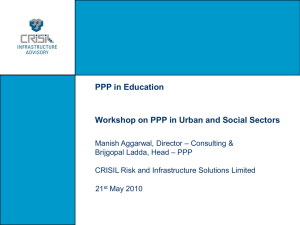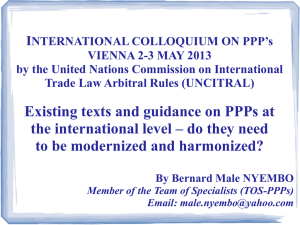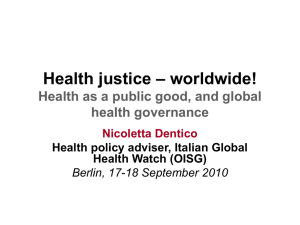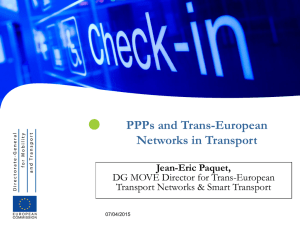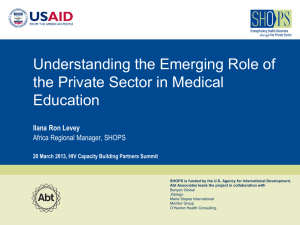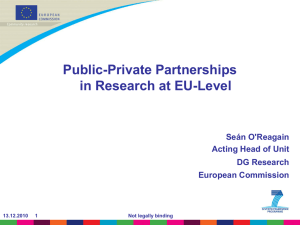The consideration of greenhouse gas emission targets
advertisement
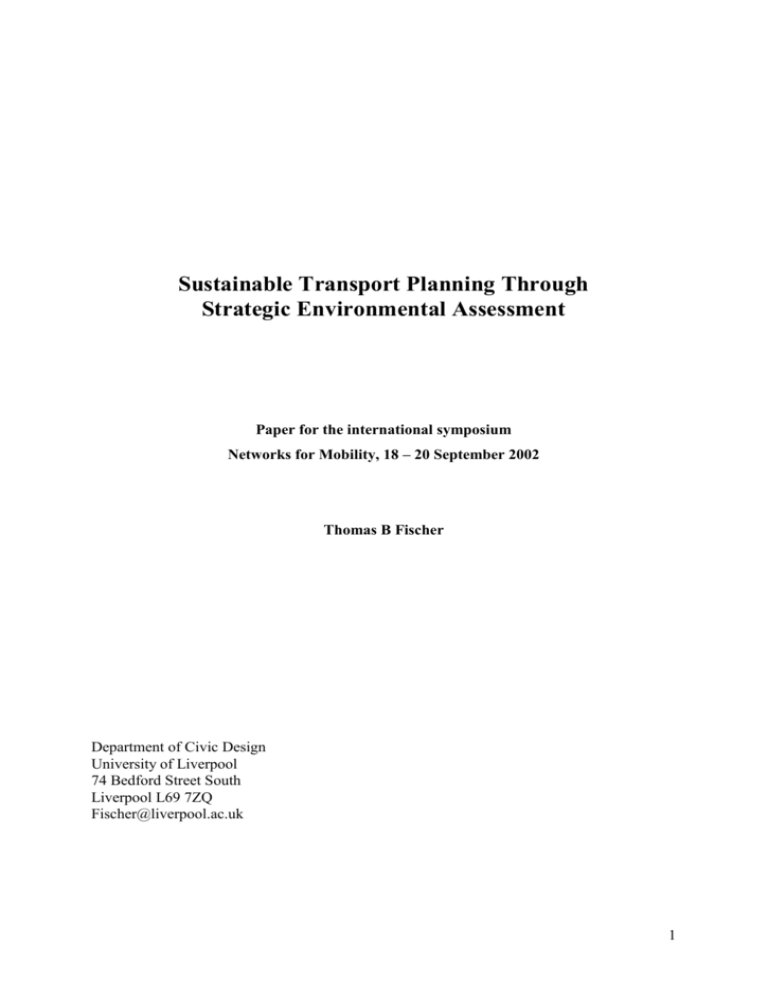
Sustainable Transport Planning Through Strategic Environmental Assessment Paper for the international symposium Networks for Mobility, 18 – 20 September 2002 Thomas B Fischer Department of Civic Design University of Liverpool 74 Bedford Street South Liverpool L69 7ZQ Fischer@liverpool.ac.uk 1 Introduction Only a joint effort of different disciplines is likely to lead to more sustainable transport. In this context, technical improvements of transport means, a reduction of trip lengths through sustainable spatial patterns and changes of traffic behaviour are important aspects. One of the preconditions for achieving the changes necessary for development to be sustainable is a better consideration of overall aims, objectives and targets in transport and spatial/land use policies, plans and programmes(PPPs). Furthermore, the likely effects arising from PPPs need to be assessed. Whilst up until now, in the European Union only project impacts have been assessed through environmental impact assessment (EIA), after July 2004, the effects of certain plans and programmes will also need to be formally addressed, using strategic environmental assessment (SEA), following the requirements of the European ‘SEA directive’ (2001/42/EC). However, one of the major shortcomings of this directive is that there will be no formal requirements to assess the impacts of policies. As every stage in the decision making hierarchy addresses different and distinct aspects, this will clearly need to change if impact assessment is to take place within effective and systematic planning systems. In order to appreciate more fully the important role SEA can play in decision making, this paper describes the potential benefits arising from SEA application. In this context, the importance of consistently applying all three SEA types is stressed, policy-SEA, plan-SEA and programme-SEA. Furthermore, it is suggested that there is now sufficient practical experience for applying SEA in a more systematic manner. Based on the existing empirical evidence, suggestions for improving current SEA practice are made. It is concluded that decision makers do not need to be afraid of applying SEA, as future formalised SEA can be based on existing practice and there is no need to reinvent the wheel. This paper consists of three parts. Part I provides a brief introduction to the different possibilities for influencing transport, including technical, regulatory, pricing-policy, infrastructure and organisational measures. Part II describes the potential benefits arising from SEA application. Most importantly these arise from a more systematic, wider and better consideration of effects and alternatives, pro-active decision making in support of sustainable development, more consistent, efficient and effective tiering and higher accountability through consultation and participation. Part III finally shows that potential benefits are not only a theoretical construct, but are observed in existing practice. In this context, the extent to which sustainability objectives and targets are considered in transport and land use policies, plans and programmes at different tiers in selected regions in the UK, the Netherlands and Germany is portrayed. Finally, conclusions are drawn. Part I: Possibilities for influencing transport There is an extensive literature on the effectiveness of different measures for influencing transport (see, for example, Newman and Kenworthy, 1999; Stead, 1999; Goodwin and Parkhurst, 1996 or Rommerskirchen, 1993). In the past, politicians and decision makers largely tended to favour technical measures; i.e. supporting technical improvements of transport means and transport infrastructures (in this context see, for example, the discussion provided by Kagermeier, 1997). However, more recently in the European Union, there has been a shift of attention and it has become clear that only a mix of different measures can 2 possibly ensure that gains in overall (technical) efficiencies will not be outweighed by quantitative growth1. Options Besides technical measures, ways for influencing transport include regulatory measures, pricing-policies, infrastructure2 and organisational measures. Pricing-policy measures have proven to be most effective in reducing transport. However, they are often politically difficult to implement and usually highly controversial. Therefore, decision makers often do not regard it feasible to increase transport costs through additional taxes or infrastructure charging, even if only to internalise external costs. To date, this has made real competition between different means of transport wishful thinking. Table 1 summarises possible options to influence transport in a simplified manner. Whilst all of the options are important elements in an overall strategy to reduce transport volumes, it needs to be stressed that currently no standard solution can be offered and different situations and problems need individual approaches. Table 1: Measures for influencing transport energy use Measures a) Technical b) Regulatory c) Pricing-policy d) Infrastructure e) Organisational Options Engines, fuels, infrastructure, telematics Emission limits, recycling targets, speed limits Internalisation of external costs, taxation Infrastructure development, spatial structure / land use2 Integrated policy, plan and programme making, assessment Source: Fischer, 2001a following in parts Goodwin and Parkhurst (1996), Acutt & Dodgson (1996), OECD (1995) Subsequently, this paper focuses on organisational measures, i.e. integrated policy, plan and programme making and impact assessment. In this context, a precondition for being effective is that policies, plans and programmes (PPPs) explicitly acknowledge and consider sustainability objectives and targets in the first place. Furthermore, proposed measures need to be assessed in terms of their ability to meet overall sustainability objectives and targets. These are necessary conditions for making transport more sustainable (see, for example Stead, 1999 and Fischer, 2002a). As will be shown later, SEA can play an important role in this context. To some extent, and particularly at the policy level, organisational measures may include all other measures, ie technical, regulatory, pricing-policy and infrastructure measures. Therefore, organisational measures can be said to have an umbrella function and should be given particular attention. The role of impact assessment In order for decisions to be taken in an informed manner, there is a need for assessing the likely impacts within planning processes. Since the 1970s, following the US American National Environmental Policy Act (NEPA), many countries world wide started introducing formalised requirements for assessing the likely environmental impacts, usually for projects only. In this context, the process based instrument most often used has become environmental 1 This is in line with the arguments of the sufficiency revolution theory (Spehl, 2000) which states that an improvement of efficiencies will not be enough for reducing energy consumption and that additional measures are needed (see also Banister, 2000 and Fischer, 2001a). 2 There has lately been much debate on whether spatial/ land use patterns can really play a substantial role for influencing transport. However, in this context, Marshall (2001) suggested that up to 70% of transport energy consumption is subject to the influence of land use planning. 3 impact assessment - EIA. Whilst structured and systematic EIA has been able to lead to improved decisions from an environmental point of view (see, for example Barker and Wood, 2001; Dipper, Jones and Wood, 1998; Marr, 1997 or World Bank, 1997), it has not been formally applied at stages above the project level. Therefore, to date, at higher tiers, decisions have been taken without properly addressing the potential environmental impacts. In the European Union (EU) this practice will change after a directive on the assessment of certain plans and programme was introduced in 2001 - the so called ‘SEA Directive’, according to which member states are required to introduce formal impact assessment for plans and programmes by July 2004. Whilst both, EIA and SEA are suitable instruments for supporting local and regional governance and providing comprehensive communication platforms, in the EU, requirements will not cover policies, thus leaving out this crucial decision making stage. However, as will subsequently be shown, SEA will only be able to develop its full potential if policies are also included in formalised impact assessment provisions. Part II: Benefits from SEA application The application of strategic environmental assessment potentially results in a number of benefits in decision making above the project level. Most importantly, these include economic benefits (saving time and money), social benefits (increasing the overall well-being of the population) and environmental benefits (avoiding environmental damage and possibly improving the biophysical environment). Benefits arise for proponents and decision makers of policies, plans and programmes and for society as a whole. Ultimately, strategic environmental assessment, if properly applied, will lead to an increase in wealth and well being through informed and sustainable decision making. Furthermore, SEA should help protecting and preserving the natural environment for the sake of future generations. This can potentially be achieved by applying objectives-led decision making approaches. SEA is expected to ultimately lead to economic benefits, as less resources will be needed for repairing environmental damage. There are not only economic benefits in terms of avoiding negative and costly effects at the end of the decision making hierarchy (i.e. at the project implementation stage), but also in terms of reducing the time involved in decision making. This is mainly caused by a streamlining effect of SEA, ie helping decision makers to address the right issues at the right time3. Current understanding is that SEA potentially addresses both, environmental and socioeconomic issues. Also, considering certain procedural steps in an objectives-led manner, SEA is an instrument in support of sustainable development, as was suggested by the European Commission in 1993 in its Fifth Action Programme: ‘Given the goal of achieving sustainable development, it seems only logical, if not essential, to apply the assessment of the environmental implications of all relevant policies, plans and programmes. An assessment of the implications for the environment will be made in the course of drawing up community policies and legislation…’ 3 whilst systematic and objectives-led decision making has lately become heavily criticised, particularly by proponents of post-modernist collaborative planning approaches (see, for example Nielsson and Dalkmann, 2001), there is enough empirical evidence to suggest that predescribed and structured decision support instuments do effectively improve decision making. For an in-depth-discussion of how SEA can be effective see Fischer (forthcoming). 4 SEA will not only help create a better local and regional environment, but also ensure that many of the global issues high on the policy agenda world-wide can be considered in policies, plans and programmes at different administrative levels. These include, for example, climate change, acidification and energy use. Key reasons for initiating SEA were said to include (Wiseman, 1997): To provide input on environmental and sustainability issues to planning or decisionmaking To reduce the number and complexity of project EIAs; and To assess cumulative impacts and identify sustainability indicators. It can be expected that if socio-economic and environmental effects are properly considered on top of the decision making hierarchy, there will be less friction and fewer problems at decision making levels at subsequent stages. This means that there are potentially overall economic benefits in terms of reducing the time necessary for development and the costs associated with socio-ecological and environmental damage (see, for example European Commission, 1996). The six aspects presented in Box 1 can be said to be mainly responsible for the overall positive benefits arising from SEA application (following Fischer, 1999, Sadler and Verheem, 1996, Lee and Walsh, 1992, Wood and Djeddour, 1992): Box 1: Potential benefits from SEA application SEA leads to a wider consideration of effects and alternatives SEA ensures proactive decision making in support of sustainable development SEA increases the efficiency of tiered decision-making in complementing project EIA SEA ensures a systematic consideration of the environment at higher tiers of decision making SEA ensures consultation and participation of experts and the general public at higher tiers of decision making SEA acts as an instrument for reconciling goals and objectives of different decision making levels The benefits arising from SEA application are not simply a theoretical construct, but are observed in practice and decision makers in many countries are aware that SEA can have positive impacts. Fischer (2001b), for example, found that opposite to what is often suggested, decision makers and planners do for the most part have rather positive opinions and attitudes towards SEA4. In this context, a majority of decision makers think that SEA will potentially lead to an acceleration of project preparation and to a better and more effective consideration of the environment in policy, plan and programme decision making. Furthermore, generally speaking, decision makers and planners do not expect SEA to lead to a delay of the preparation of the underlying PPP. Some decision makers even expect that SEA will be able to lead to an acceleration of PPP preparation, mainly due to the streamlining effect of the SEA process, which helps to achieve a more systematic consideration of the different aspects of decision making. Also, the integration of SEA into the PPP making process is usually considered as being rather straightforward. 4 However, positive attitudes are not necessarily observed with politicians. 5 SEA leads to a wider consideration of effects and alternatives The potential impacts of PPPs can be addressed and evaluated within the PPP making process through SEA. In this context, the SEA process may also help to identify impacts that are not directly obvious. These include impacts resulting from the stimulation of other developments by a certain activity, for example transport impacts from urban sprawl (induced impacts). Furthermore, they may include synergistic impacts that may be the result of the combined impacts of several projects exceeding the sum of individual impacts. Furthermore, SEA covers long range, delayed and global impacts (e.g. greenhouse gas emissions or chlorofluorocarbon emissions). SEA is also able to deal with cumulative effects of small projects or nonproject actions, for which no project EIAs are conducted (see, for example, Lee and Walsh, 1992). In order to do so, SEA will need to address the cumulative effects of the entire PPP. The application of SEA may lead to the consideration of alternatives in PPP making that would otherwise not have been considered, including both, alternative sites and modes. In the context of the consideration of alternatives, different scenarios may also be considered, such as different economic or population growth rates. SEA ensures proactive decision making in support of sustainable development SEA is potentially a proactive instrument helping to address causes of environmental impacts rather than simply treating symptoms of environmental deterioration (as was suggested by Sadler and Verheem, 1996). Starting at the outset of the PPP process, SEA can help enhance the credibility and acceptability of decisions (Goodland and Tillmann, 1995). Applied at the beginning of the PPP process, it can help to identify overall policy goals and objectives, for example from sustainable development strategies. These are likely to include socio-economic and environmental effects. In this context, SEA can also provide a platform for conducting consistency analyses of different goals and objectives (see below). Within a systematic and objectives-led process, SEA can lead to the formulation of sustainable PPPs. Therefore, it can potentially act as a decision making support instrument for better structuring and shaping PPP processes (Riehl and Winkler-Kühlken, 1995). Pro-active assessment within decision-making towards achieving ‘sustainable development’ may consist of a number of (possibly cyclical) steps and can be integrated into a process similar to that of project EIA. This is shown in Figure 1. Figure 1: Simplified process for the integration of the PPP formulation process and SEA public participation and consultations Identification of impacts of PPP on defined objectives/screening Targets setting and identification of scenarios, alternatives, options/ scoping Impact assessment/SEA report Monitoring and follow-up Source: Fischer, 2002a SEA increases efficiency of tiered decision-making Current practice in Western and Northern European countries shows that there are different distinct stages in the planning hierarchy, comprising two main components - administrative 6 and systematic tiers. Whilst there is currently evidence that PPPs and informal SEAs are prepared at all tiers, no known system currently systematically covers all of them. This shortcoming will need to be overcome, if PPP making is to take place in a more effective and systematic manner. Figure 2 shows the main elements in administrative and systematic tiering in a simplified manner. Figure 2: Administrative and systematic tiering aspects in the decision making cycle Systematic Tiering Admin- National istra- Regional tive local Policies Plans Programmes Projects Source: Fischer, 2001a Fully developed tiered decision making systems are of great importance for SEA to be able to develop its full potential, as was suggested by ICON, (2001, V): ‚in the absence of tiering, communication processes become broken or interrupted, creating dissonance with other levels of decision making‘ Currently, in many planning systems world wide, assessments of environment and socioeconomic effects only take place at lower stages of the decision making hierarchy, in many cases only at the project level. However, project-EIA starts too late in the decision making hierarchy in order to cover the full range of alternatives, particularly intermodal alternatives. Figure 3 shows the quantity of information and concrete site specific issues, to be regarded at different stages in the decision making hierarchy. Figure 3: Quantity of substantive information provided by different tiers of decision making Quantity of information Range of concrete, site specific issues Range of possible alternatives Policies Plans Programmes Decision making tier Source: Fischer, 2002b Resistance to certain developments may be the result of an insufficient consideration of environmental issues at higher tiers of decision making. This may, in effect lead to delays and other problems at the project stage. The application of SEA within fully developed tiered planning systems supports the consideration of the right planning issues at the right time. If those issues currently not considered in the planning hierarchy are addressed through SEA, a shortening or at least simplification of project EIA can result, speeding up the project making process. In this context, in order to make decision making more efficient, it is helpful if SEA formulates standard or generic mitigation measures for later projects (Wood and Djeddour, 1992). 7 SEA allows for an early consideration of environmental goals, objectives and targets when a wide range of possible options and alternatives still exists. It may thus help determine the need and feasibility of initiatives and proposals. However, this is only achieved effectively in a consistent manner if there are clear SEA provisions and requirements for all decision making tiers and if authorities and initiating agencies are fully accountable in transport decision making. Administrative tiering Transport related planning is conducted at different geographical levels requiring the consideration of different planning aspects. Fischer (2001a) summarised those aspects that might be addressed, for example at local, regional or national levels. At the local level, aspects include the development of an urban fabric that enables a city of ‘short distances’ with mixed land use, good public participation, parking restrictions in inner city areas, parking fees and overall minimum densities. At the regional level, decision making towards the development of a regional spatial structure that favours public transport use might be encouraged, for example within a spatial system of ‘decentralised concentration’ (see also Krüger, Rathmann and Utech, 1972 and Newman and Kenworthy, 1999). At the national level, certain fundamental policy and legal aspects are usually dealt with most effectively. Systematic tiering As explained above, any decision making and SEA documentation above the project level can be allocated to either the policy, the plan or the programme tier. There are certain tasks to be addressed by SEA at any of the three levels, which are subsequently summarised. Policy-SEA is found on top of the decision making hierarchy. Its main purpose is to assess the impacts of unlimited policy options, such as fiscal, economic and regulatory measures and intermodal alternatives. Furthermore, inter-sectoral and cumulative impacts are considered and assessments are fully integrated into the underlying policy. In addition, scenarios regarding the potential population or economic developments can be considered. Plan-SEA is prepared subsequently to policy-SEA, comparing potential spatial options and alternatives. Whilst current practice indicates a focus on environmental impacts, socio-economic impacts might also be assessed, if sustainable development is the leading objective (Fischer et al. 2002). Programme-SEA, finally identifies project priorities, taking socio-economic and environmental factors into account. Programme-SEA relies on either multi-criteria analysis or cost-benefit analysis and is applied before project preparation. Figure 4 summarises focus and tasks to be addressed at the different decision making tiers. 8 Figure 4: Tasks of systematic decision making tiers D e c is io n m a k in g tie r P o lic ie s F ocus T asks A ll o p tio n s th a t m ig h t le a d to m e e tin g o b je c tiv e s a n d ta rg e ts c o lle c tin g e x is tin g e c o n o m ic , s o c ia l a n d e n v iro n m e n ta l o b je c tiv e s a n d ta rg e ts id e n tify in g p o s s ib le p o lic y o p tio n s P la n s S p a tia l d e v e lo p m e n t o p tio n s le a d in g to s p e c ific p ro je c ts P rogram m es P rio rity p ro je c ts P r o je c ts P ro je c t d e s ig n id e n tify in g d iffe re n t d e v e lo p m e n t s c e n a rio s , in d ic a tin g n e c e s s a ry tra d e -o ffs in te rm s o f a n a c h ie v e m e n t o f o b je c tiv e s a n d ta rg e ts (p o lic y -a s s e s s m e n t ) m o n ito rin g a c tu a l d e v e lo p m e n ts re g u la r a d ju s tm e n ts o f p o lic ie s id e n tify in g s p a tia l d e v e lo p m e n t o p tio n s a c c o rd in g to n e e d s id e n tifie d in p o lic ie s a s s e s s in g im p a c ts o n d iffe re n t o p tio n s to a c h ie v e o b je c tiv e s a n d ta rg e ts ( p la n a s s e s s m e n t) m o n ito rin g a c tu a l d e v e lo p m e n ts re g u la r a d ju s tm e n ts o f p la n s id e n tify in g p rio rity p ro je c ts u s in g m u ltic rite ria -a n a lys is o r c o s t-b e n e fit a n a ly s is (p ro g ra m m e -a s s e s s m e n t) m o n ito rin g a c tu a l d e v e lo p m e n ts re g u la r a d ju s tm e n t o f p ro g ra m m e s o p tim is e p ro je c t d e s ig n in te rm s o f p o lic y o b je c tv e s a n d ta rg e ts ( p ro je c t-a s s e s s m e n t) m o n ito rin g a c tu a l d e v e lo p m e n ts Source: adapted from Fischer and Seaton, 2002 SEA ensures consultation and participation of experts and the general public at higher tiers of decision making Early widespread consultation and participation of the public, non-governmental organisations and other bodies help determining possible problems in PPP making on top of the decision making hierarchy and prevent future delays in planning due to public opposition (Sheate, 1992). It also helps to ensure that decision makers are accountable. If there are existing PPP consultation and participation processes, SEA can be integrated into these. SEA as an instrument for reconciling different decision making levels Differing and inconsistent goals and objectives are a major challenge to decision making for sustainable development. These include goals and objectives of different administrative tiers, of the three main systematic decision making levels and of different sectors. SEA application helps reconciling differing goals and objectives through integration, thus uncovering inconsistencies and providing a platform for suggestions on how to achieve sustainable development. In connection with the currently widely propagated move towards regionalisation, SEA application at the regional level allows to reconcile national and local levels of decision making. 9 Part III: The consideration of overall objectives and targets in transport and spatial/ land use PPPs and the role of SEA In order to clarify the beneficial role SEA can play in PPP making, this section provides some empirical evidence showing that SEA is indeed able to improve current practice. In this context, the consideration of climate change and greenhouse gas emission targets are taken as examples. This is based on the analysis of 36 transport and spatial/land use PPPs from North West England, Noord-Holland and Brandenburg-Berlin in 1997/8. Of the 36 PPP, 25 involved some form of informal SEA. 10 SEAs were allocated to the policy-SEA type, eight to the plan-SEA type and seven to the programme-SEA type. An in an-depth description of the results is presented by Fischer (2002a). Subsequently, success criteria for an effective consideration of climate change and greenhouse gas emission targets are identified. The consideration of climate change as an objective in transport and spatial/land use PPPs Figure 5 shows the extent to which the 36 PPPs, representing all administrative levels in the three regions, considered climate change as an overall objective. In total, only one third of all PPPs did so. Whilst 60% of all transport PPPs considered climate change, only 10% of the spatial/land use PPPs did so. The application of SEA clearly had a positive effect. Whilst 43% of those PPPs involving SEA considered climate change, only 15% of the PPPs not involving SEA did so. Regarding the different SEA types, there are significant differences. Whilst 80% of all those PPPs involving policy-SEA and 58% of those involving programme-SEA considered climate change, none of those involving plan-SEA did so. This is mainly explained by the spatial focus of plans, examining spatial alternatives for anticipated future developments, thus leaving out other effects apart from those that are directly land use related. Considering the important role spatial patterns can play in influencing transport energy consumption (see Marshall, 2001), this clearly should change. Based on these results it may be suggested that if policy-SEA is not applied, it is doubtful whether decision making will end up giving due consideration to issues such as global climate change. Figure 5: The extent to which climate change is considered in PPPs and the role of SEA 0 10 20 30 40 50 60 70 80 90 100 % Total Policy-SEA Plan-SEA Programme-SEA Transport Spatial/land use SEA no SEA Source: Based on data from Fischer (2002a) 10 The consideration of greenhouse gas emission targets in transport and spatial/land use PPPs Only roughly one fifth of the 36 PPPs explicitly considered greenhouse gas emission targets, usually stating that no increase in transport generated CO2 emissions should occur. Whilst greenhouse gas emission targets were mostly said to be implicitly considered, it remains unclear what this means and whether an implicit consideration has any effect on final outcomes. Only 10% of the spatial/land use PPPs considered targets at all. Whilst 50% of those PPPs involving policy-SEA considered targets, none of those involving any of the other two SEA types did so. This is the main reason for PPPs involving SEA only scoring slightly better than those not involving any SEA at all. Again, these results clearly show the important role of policy-SEA. Figure 6: The extent to which greenhouse gas emission targets are considered in PPPs and the role of SEA 0 10 20 30 40 50 60 70 80 90 % 100 Total Policy-SEA Plan-SEA Programme-SEA Transport Spatial/land use SEA no SEA Source: Based on data from Fischer (2002a) Factors leading to a better consideration of climate change and greenhouse gas emission targets The most important factor for the consideration of climate change and greenhouse gas emission targets in 36 transport and spatial/land use PPPs in North West England, NoordHolland and Brandenburg-Berlin was the application of policy-SEA (statistically significant at P≥.01). Furthermore, the extent to which SEA procedural stages were considered (see Figure 1) was positively correlated with the consideration of climate change (P≥.05). In this context, the participation of the general public and consultation of external bodies played a important role (both only marginally failing to be statistically significant at P≥.05). According to the results presented above, a decision making process that is most likely to ensure the consideration of climate change and greenhouse gas emission targets in policy, plan and programme making therefore integratively includes a systematic SEA process, consisting of 11 screening, scooping, impact assessment and monitoring stages and involves public participation and consultation at all major stages of decision making5. In order for SEA to be successful, in addition to procedural elements, the institutional context also needs to be in favour of sustainable PPP making. This includes positive attitudes of decision makers, without which no overall good results can be achieved. Finally, the integrative consideration of environmental and socio-economic aspects are of importance in order to improve current practice. This can also be achieved by applying SEA. Conclusions There are currently a number of option for supporting a reduction of transport volumes. These can be summarised to include technical, regulatory, pricing-policy, infrastructure and organisational measures. The latter category includes policy, plan and programme making and impact assessment. Whilst in most countries, environmental aspects are currently assessed only at the project level in a formal manner, strategic environmental assessment (SEA) can improve overall performance at strategic levels of decision making. SEA is a systematic procedural decision making support instrument in sustainable policy, plan and programme making, aiming at an appropriate consideration of the environment. Its consistent application results in a number of potential benefits, including a systematic, wider and better consideration of effects and alternatives in proactive and efficiently tiered strategic decision making for sustainable development, complementing project EIA. Furthermore, SEA can help reconciling goals and objectives and enhance accountability of decision makers through consultation and participation. In order to develop its potentially beneficial role fully, SEA needs to be consistently applied in the decision making hierarchy, at the levels of policies, plans and programmes. Not conducting SEA at any of these stages results in reduced SEA effectiveness. An analysis of the consideration of climate change and greenhouse gas emission targets in transport and spatial/land use policies, plans and programmes in North West England, NoordHolland and EVR Brandenburg-Berlin leads to the conclusion that SEA is able to substantially improve performance. In this context, SEA application at the policy level plays a particular important role. It is concluded that current practice can largely be improved, if formalised SEA is conducted for policies, plans and programmes, consisting of predetermined procedural stages and allowing for widespread consultation and participation. References Acutt M Z and Dodgson J S 1996. Transport and global warming - modelling the impacts of alternative policies, paper presented at the final conference for the ESRC Research Programme ‘Transport and the Environment’, Regent’s College Conference Centre, 22 March 1996, London. Banister D 2000. Sustainable urban development and transport - a Eurovision for 2020, Transport Reviews 20, 1:113-130. Barker A and Wood C 2001. Environmental assessment in the European Union: perspectives, past, present and strategic, European Planning Studies, 9(2): 243-254. 5 The role of the different stages is explained by Fischer (2002a). For the importance of monitoring and follow up in SEA see also Partidario and Fischer (forthcoming). 12 Dipper B, Jones C and Wood C 1998. Monitoring and post-auditing in environmental impact assessment: a review, Journal of Environmental Planning and Management 41(6): 731-747. European Commission 1996. EIA – a Study on Costs and Benefits, Brussels. European Commission 1993. Towards Sustainability - A European Community Programme of Policy and Action in Relation to the Environment and Sustainable Development (Fifth Environmental Action Programme), Directorate General Environment, Nuclear Safety and Civil Protection (DG XI), Brussels. Fischer T B 2002a. Strategic Environmental Assessment in Transport and Land use Planning, Earthscan, London. Fischer T B 2002b. Towards a more systematic approach to policy, plan and programme environmental assessment – some evidence from Europe, in: Marsden, S. and Dovers, S. (eds.) SEA in Australasia, Sydney Place Federation Press. Fischer T B 2001a. Towards a better consideration of climate change and greenhouse gas emission targets in transport and spatial/ land use policies, plans and programmes http://sedac.ciesin.org/openmeeting/downloads/1003159123_presentation_rio2.doc Fischer T B 2001b. The practice of environmental assessment for transport and land use policies, plans and programmes, Impact Assessment & Project Appraisal, 19(1): 41-51. Fischer T B 1999. Benefits from SEA application - a comparative review of North West England, Noord-Holland and EVR Brandenburg-Berlin, EIA Review, 19: 143-173. Fischer T B, Wood C and Jones C 2002. Improving the practice of policy, plan and programme environmental assessment, Environment and Planning B, 29(2): 159-172. Fischer T B and Seaton K 2002. Strategic environmental assessment – effective planning instrument or lost concept? Planning Practice and Research, 17(1): 31-44. Fischer T B (forthcoming). Strategic Environmental Assessment in post-modern times. Goodland R and Tillmann G 1995. Strategic Environmental Assessment, Shell International B.V., Health, Safety and Environment Division, The Hague. Goodwin P and Parkhurst G 1996. The real effects of “environmentally friendly” transport policies, paper presented at the final conference for the ESRC Research Programme ‚Transport and the Environment‘, 22 march 1996, Regent's College, London. Kagermeier A 1997. Siedlungsstruktur und Verkehrsmobilität, Dortmunder Vetrieb für Bauund Planungsliteratur, Dortmund. Lee N and Walsh F 1992. Strategic environmental assessment: an overview, Project Appraisal 7(3): 126-136. Marr K 1997. Environmental Impact Assessment in the UK and Germany, Ashgate, Aldershot. 13 Marshall S 2001. The challenge of sustainable transport, in: Layard A, Davoudi S and Batty S (eds). Planning for Sustainable Development, London, Spon. Newman P and Kenworthy J 1999. Sustainability and Cities – Overcoming Automobile Dependence, Island Press, Washington, DC. Nielsson M N and Dalkmann H 2001. Decision making and strategic environmental assessment, Journal of Environmental Assessment Policy and Management, 3(3): 305-328. OECD - Organisation for Economic Co-operation and Development 1995. Urban Travel and Sustainable Development, European Conference of Ministers of Transport (ECMT), Paris. Partidario M R and Fischer T B (forthcoming). The meaning of follow-up and monitoring in current SEA, in: Morrison A and Arts J (eds). Environmental Assessment Follow-up, Earthscan, London. Riehl C and Winkler-Kühlken B 1995. Environmental Impact Assessment in Area Master Planning: Practical Problems and Suggested Solutions, Institut für Stadtforschung und Strukturpolitik GmbH, Berlin. Rommerskirchen S 1993. The effects of individual measures, and of combinations of measures, on reducing CO2 emissions of transport in Germany, in: The European Conference of Ministers of Transport (ECMT): Reducing Transport’s Contribution to Global Warming, Conclusions of ECMT Seminar, 30.09. - 01.10.1992, ECMT, Paris. Sadler B and Verheem R 1996 SEA - Status, Challenges and Future Directions, Ministerie van Volkshuisvesting, Ruimtelijke Ordening en Milieubeheer, Den Haag. Sheate W 1992. Strategic Environmental Assessment in the Transport Sector, Project Appraisal 7 (3), 170-174. Spehl H 2000. Nachhaltige Entwicklung und ökologische Ökonomie – ein Ansatz für Raumordnung und Regionalpolitik, in: Akademie für Raumforschung und Landesplanung (ed.). Beiträge zur theoretischen Grundlegung der Raumentwicklung, Hannover Stead D 1999. Planning for Less Travel – Identifying Land Use Characteristics Associated with More Sustainable Travel Patterns, PhD-thesis, University College London. World Bank, 1997. The Impact of Environmental Assessment: A Review of World Bank Experience, Washington, DC. Wiseman K 1997. Environmental Assessment and Planning in South Africa: The SEA connection. Paper presented at the annual meeting of the International Association for Impact Assessment (IAIA) in New Orleans, June. Wood C and Djeddour M 1992 Strategic environmental assessment: EA of policies, plans and programmes Impact Assessment Bulletin 10: 3 – 22. 14
